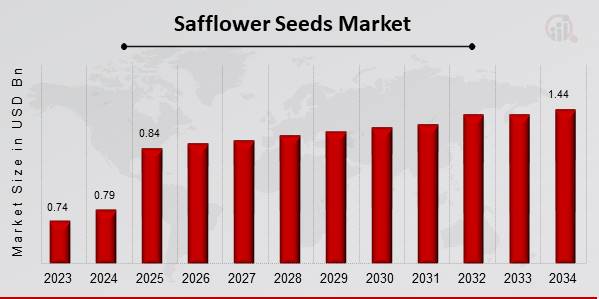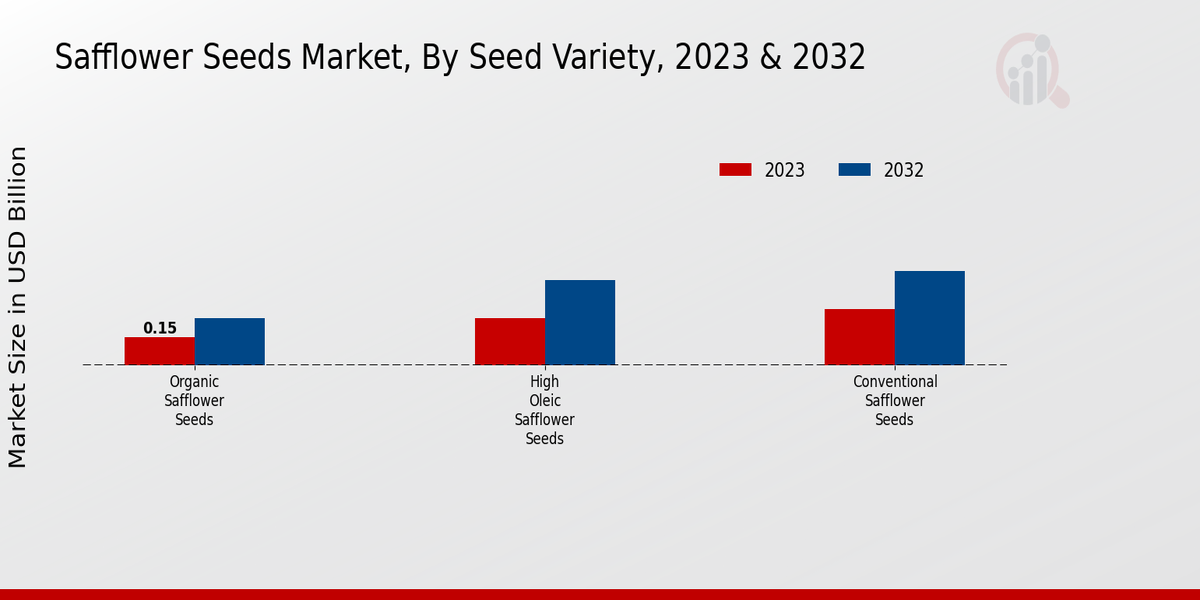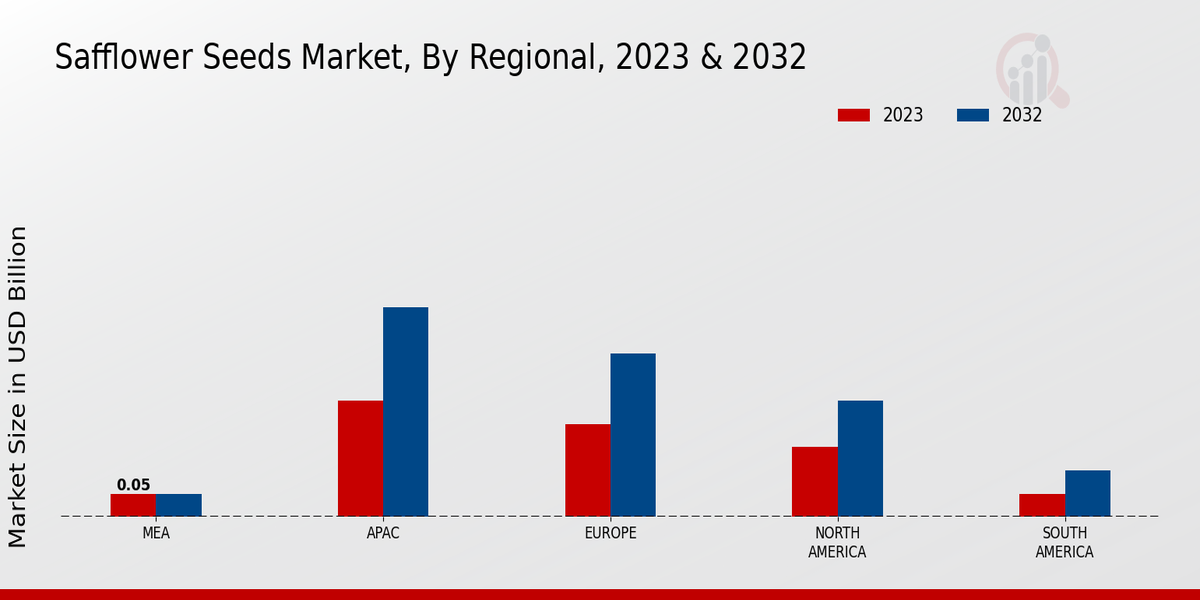Global Safflower Seeds Market Overview
Safflower Seeds Market Size was estimated at 0.79 (USD Billion) in 2024. The Safflower Seeds Market Industry is expected to grow from 0.84 (USD Billion) in 2025 to 1.44 (USD Billion) by 2034. The Safflower Seeds Market CAGR (growth rate) is expected to be around 6.2% during the forecast period (2025 - 2034).

Source: Primary Research, Secondary Research, MRFR Database and Analyst Review
Key Safflower Seeds Market Trends Highlighted
The Safflower Seeds Market is significantly driven by increasing demand for healthy and nutritious food options, as safflower oil is recognized for its high levels of unsaturated fats and low saturated fat content. Moreover, the rising awareness of health benefits associated with safflower seeds, including their potential role in reducing cholesterol levels, has notably propelled market growth. Additionally, the growing trend toward organic farming and the adoption of non-GMO crops are further enhancing the popularity of safflower production.There are ample opportunities to be explored in the market, particularly in the development of innovative safflower-based products for culinary and cosmetic applications. The expanding interest in natural remedies and herbal products creates new revenue avenues for safflower seeds, especially in the wellness sector. Furthermore, partnerships between agricultural producers and food manufacturers can facilitate the introduction of safflower seed ingredients into mainstream consumer products, thus enhancing their market penetration.Trends in recent times have indicated a shift towards sustainable agricultural practices, with farmers increasingly adopting eco-friendly cultivation methods. This shift not only aligns with consumer preferences for sustainably sourced products but also contributes to the bio-diversity of crops available in the market. The emergence of new technologies in seed processing and extraction methods also represents a notable trend, potentially improving the efficiency and quality of safflower oil production. As consumer trends evolve and the focus on health and sustainability amplifies, the Safflower Seeds Market is poised for further expansion and innovation.
Safflower Seeds Market Drivers
Rising Demand for Healthier Cooking Oils
The increasing focus on health and wellness among consumers has driven the demand for healthier and more natural cooking oils. Safflower oil, derived from safflower seeds, is regarded for its high smoke point and is rich in unsaturated fats, making it a preferred choice among health-conscious individuals. The trend towards healthier dietary options is not only a response to lifestyle changes but also a recognition of the importance of incorporating essential fatty acids into daily nutrition.This growing awareness about the benefits of safflower oil has led to its increased consumption across various culinary applications, thereby spurring growth in the Safflower Seeds Market Industry. The market is further augmented by innovations in food processing and heightened marketing efforts to promote safflower oil as a heart-healthy alternative to more traditional cooking oils. With the expected growth in market value, this trend is likely to persist as consumers continue to prioritize their health and seek out natural, unrefined cooking oils that deliver on both flavor and nutritional value.As a result, the impact of this driver is anticipated to significantly influence the trajectory of the Safflower Seeds Market moving forward.
Surge in Organic Farming
The shift towards organic farming practices is a key driver for the Safflower Seeds Market Industry. As more farmers adopt organic methods in response to consumer demand for chemical-free products, safflower seeds have gained popularity as a sustainable crop. Safflower's resilience and ability to thrive in arid conditions make it a suitable choice for organic farming, leading to its expanded cultivation. This organic trend not only aligns with environmental sustainability but also supports the production of high-quality oil, further enhancing market prospects.
Growing Use in Cosmetics and Personal Care Products
Safflower seeds are increasingly being used in the cosmetics and personal care industry due to their beneficial properties. Safflower oil is known for its moisturizing and skin-nourishing attributes, making it a valuable ingredient in lotions, creams, and hair care products. As the trend for natural and organic beauty products continues to rise, the demand for safflower oil is expected to grow substantially, further driving the Safflower Seeds Market Industry.This demand is bolstered by consumer preferences for clean beauty products that are free from harmful chemicals.
Safflower Seeds Market Segment Insights
Safflower Seeds Market Seed Variety Insights
The Safflower Seeds Market segment focusing on Seed Variety displays a robust landscape characterized by varied types, with the overall market poised at a valuation of 0.7 USD Billion in 2023. Within this segment, High Oleic Safflower Seeds emerge as a dominant category, accounting for a significant portion with a valuation of 0.25 USD Billion, expected to grow to 0.45 USD Billion by 2032. This growth can be attributed to the rising demand for oil with beneficial fatty acid profiles which are seen as healthier alternatives in culinary applications.Following closely, Conventional Safflower Seeds hold a valuation of 0.3 USD Billion in 2023, projected to reach 0.5 USD Billion by 2032. The popularity of this category is primarily driven by traditional agricultural practices and relatively lower costs, making it accessible for a wider range of consumers. Meanwhile, Organic Safflower Seeds are also gaining traction, though they are smaller in market share, with a current value of 0.15 USD Billion, projected to increase to 0.25 USD Billion by 2032. This sub-segment's growth is largely influenced by the increasing consumer preference for organic products driven by health and environmental concerns, thus highlighting a significant movement toward sustainable agricultural practices.As the Safflower Seeds Market continues to evolve, the discernible trends indicate a steady demand in the Seed Variety segment, propelled by consumer awareness regarding health benefits and sustainable agriculture, positioning these seeds as vital components in both regional and global agricultural sectors. The continued diversification and innovation in seed varieties will further enhance their acceptance and market growth, aiding farmers and agricultural businesses in maximizing yield and profitability.

Source: Primary Research, Secondary Research, MRFR Database and Analyst Review
Safflower Seeds Market Application Insights
The Safflower Seeds Market, valued at 0.7 billion USD in 2023, is experiencing notable growth across its application segments. The demand for safflower oil production is rising due to its health benefits and high unsaturated fatty acid content, making it a preferred choice for consumers seeking healthier cooking oils. In the animal feed sector, safflower seeds provide a nutrient-rich option that supports livestock health and is favored for its high protein content, thus playing a vital role in the agriculture industry. The food products application is also gaining traction, as safflower seeds are used in various culinary products, offering nutritional advantages and versatility.The cosmetics sector has witnessed an increase in demand as well, where safflower oil is recognized for its moisturizing properties, playing an essential role in skincare formulations. Overall, the Safflower Seeds Market segmentation showcases diverse opportunities driven by health trends, enhancing market growth and paving the way for future developments in these key applications.
Safflower Seeds Market Distribution Channel Insights
The Safflower Seeds Market is projected to showcase diverse Distribution Channels, with a strong emphasis on Direct Sales, Retail, and Online Sales. The overall market was valued at 0.7 billion USD in 2023, reflecting a growing interest in safflower seeds due to their numerous agricultural benefits. Direct Sales has been significant in reaching farmers directly, allowing them to obtain quality seeds tailored for specific agricultural needs. Retail outlets provide convenience and broader accessibility for consumers, making it easier for them to purchase safflower seeds.Online Sales has emerged as a dominant force, especially with the increasing trend of e-commerce, offering consumers the ease of shopping from home while enabling farmers access to a wider variety. The Safflower Seeds Market revenue indicates that the preference for purchasing through these channels is likely to continue evolving, bolstered by advancements in digital marketing and logistics. Moreover, the market statistics reveal that the engagement in these channels is crucial for driving market growth and ensuring the steady supply of safflower seeds.Each distribution method plays a vital role in addressing customer preferences and enhancing overall accessibility to the thriving safflower seeds industry.
Safflower Seeds Market Geographical Usage Insights
The Safflower Seeds Market revenue is positioned to witness growth with a valuation of 0.7 billion USD in 2023. This market is divided based on geographical usage, highlighting significant areas like Agricultural Use and Research Development. Agricultural Use remains a pivotal segment as safflower seeds are crucial for oil extraction, animal feed, and as a crop rotation option, promoting sustainability and soil health. The significance of Research Development in this market cannot be understated, as it drives innovation and the development of improved safflower varieties catering to consumer needs and environmental challenges.Research efforts are focused on enhancing yield and disease resistance, which can ultimately benefit agricultural productivity and support market growth. The increasing interest in natural oils and sustainable farming practices further propels both segments, indicating a positive trajectory for the Safflower Seeds Market statistics in the coming years. As the demand for safflower flourishes in various regions, it presents numerous opportunities for advancement and investment within the industry.
Safflower Seeds Market Market Type Insights
The Safflower Seeds Market is witnessing notable growth, reflecting a current valuation of approximately 0.7 USD Billion in 2023. This market segment consists of different types, primarily focusing on Conventional and Organic markets. The Conventional Market remains a dominant force, attributed to its broader acceptance among farmers who prioritize cost-effectiveness in seed procurement. On the other hand, the Organic Market is gaining traction, driven by increasing consumer preference for sustainably produced agricultural products and growing health consciousness surrounding organic food consumption.The market's evolving landscape is fueled by trends such as the rising demand for healthier oils and robust agricultural techniques. However, challenges such as fluctuating weather conditions and potential pest threats pose risks to overall productivity. Nevertheless, opportunities for innovation in seed varieties and sustainable farming practices remain significant drivers for market growth. The Safflower Seeds Market data underscores the transition towards more sustainable solutions, as indicated by the expected valuation of 1.2 USD Billion by 2032.The competition in the Safflower Seeds Market segmentation is set to intensify as both Conventional and Organic markets strive to meet the increasing needs of diverse consumer segments.
Safflower Seeds Market Regional Insights
The Safflower Seeds Market is projected to experience steady growth across regional segments, reflecting varying dynamics and valuations. In 2023, the Asia Pacific segment holds a significant valuation of 0.25 USD Billion, indicating its majority holding in the market due to increasing demand for healthier oil options and agricultural expansion. Europe follows with a valuation of 0.2 USD Billion, showcasing its role in the health-conscious and sustainable food sector. North America, valued at 0.15 USD Billion in 2023, is notable for its innovative agricultural practices and crop diversity, which contribute to market growth.Meanwhile, the Middle East and Africa, with a valuation of 0.05 USD Billion, reflects a niche yet stable demand, whereas South America, also valued at 0.05 USD Billion, has room for expansion, particularly in organic and specialty crops. The total valuation for the Safflower Seeds Market is expected to enhance further as trends toward healthy eating and sustainable agriculture gain momentum, highlighting the importance of regional market engagement and strategic initiatives in driving overall market growth.

Source: Primary Research, Secondary Research, MRFR Database and Analyst Review
Safflower Seeds Market Key Players and Competitive Insights:
The Safflower Seeds Market showcases a dynamic landscape characterized by increasing demand for safflower oil, which is gaining popularity due to its health benefits and versatility in culinary applications. This market is influenced by various factors, including agricultural practices, climatic conditions, and consumer preferences. Key players within this space are constantly strategizing to enhance their product offerings and improve market penetration. As the demand for natural and health-focused products rises, competition is increasingly driven by innovation, quality, and sustainability initiatives. This competitive environment compels companies to differentiate their products through research and development, establishing partnerships, and optimizing supply chains to meet the varied expectations of consumers and agricultural industries.BASF SE has established itself as a formidable player in the Safflower Seeds Market, leveraging its extensive experience in crop protection and seed technology. The company’s strong focus on research and development has enabled it to introduce high-yielding safflower varieties that are resistant to diseases and environmental stresses. This innovative approach not only supports farmers in achieving higher productivity but also enhances the overall quality of safflower seeds. Additionally, BASF SE’s global presence ensures that it maintains a robust distribution network, allowing the company to cater to diverse agricultural needs across various regions. Their commitment to sustainability and responsible sourcing practices further strengthens their brand reputation, making them a preferred choice among safflower seed producers.Sakata Seed Corporation plays a significant role in the Safflower Seeds Market by focusing on high-quality seed production and exceptional customer service. The company emphasizes thorough research and experimentation to develop safflower varieties that are well-suited to different climatic conditions. This allows them to meet the unique requirements of growers in various geographical locations. Sakata Seed Corporation’s strength lies in its vast experience in the seed industry, along with an unwavering dedication to quality control and innovation. Their comprehensive approach not only ensures the delivery of reliable seed products but also enhances the overall agricultural practices of their clientele. With a solid reputation in the market, Sakata Seed Corporation continues to carve a niche within the competitive landscape of safflower seeds by prioritizing both product excellence and customer satisfaction.
Key Companies in the Safflower Seeds Market Include
- BASF SE
- Sakata Seed Corporation
- Corteva Agriscience
- Safflower Technologies
- Nuziveedu Seeds
- Allseed
- Syngenta AG
- Aarav Impex
- Mahyco
- Bayer AG
- Tuscany Seed
- SeedWorks International
- Dupont
- Limagrain
- Hannah Seed
Safflower Seeds Market Industry Developments
Recent developments in the Safflower Seeds Market reflect a growing interest in the health benefits and agricultural versatility of this oilseed crop. Increased demand for healthy cooking oils and natural ingredients has driven innovations in safflower cultivation, focusing on higher oil content and improved disease resistance. Countries like the United States, India, and China are enhancing their safflower production capabilities through advanced farming techniques and biotechnology. Additionally, sustainability initiatives are gaining traction, with farmers adopting practices that minimize environmental impact while maximizing yield. Market players are also exploring opportunities in product diversification, such as safflower-based health supplements and cosmetics, further expanding the market scope. The evolving preferences for plant-based products amidst rising health consciousness are expected to significantly influence market dynamics. Collaborative efforts among stakeholders, including researchers, agronomists, and agribusinesses, aim to address challenges such as climate change and supply chain disruptions, ensuring a resilient safflower seeds market leading up to 2032. Such trends indicate a positive outlook for the sector, with significant growth opportunities anticipated in the coming years.
Safflower Seeds Market Segmentation Insights
-
Safflower Seeds Market Seed Variety Outlook
- High Oleic Safflower Seeds
- Conventional Safflower Seeds
- Organic Safflower Seeds
-
Safflower Seeds Market Application Outlook
- Oil Production
- Animal Feed
- Food Products
- Cosmetics
-
Safflower Seeds Market Distribution Channel Outlook
- Direct Sales
- Retail
- Online Sales
-
Safflower Seeds Market Geographical Usage Outlook
- Agricultural Use
- Research Development
-
Safflower Seeds Market Market Type Outlook
- Conventional Market
- Organic Market
-
Safflower Seeds Market Regional Outlook
- North America
- Europe
- South America
- Asia Pacific
- Middle East and Africa
| Report Attribute/Metric |
Details |
| Market Size 2024 |
0.79 (USD Billion) |
| Market Size 2025 |
0.84 (USD Billion) |
| Market Size 2034 |
1.44 (USD Billion) |
| Compound Annual Growth Rate (CAGR) |
6.2% (2025 - 2034) |
| Report Coverage |
Revenue Forecast, Competitive Landscape, Growth Factors, and Trends |
| Base Year |
2023 |
| Market Forecast Period |
2025 - 2034 |
| Historical Data |
2019 - 2023 |
| Market Forecast Units |
USD Billion |
| Key Companies Profiled |
BASF SE, Sakata Seed Corporation, Corteva Agriscience, Safflower Technologies, Nuziveedu Seeds, Allseed, Syngenta AG, Aarav Impex, Mahyco, Bayer AG, Tuscany Seed, SeedWorks International, Dupont, Limagrain, Hannah Seed |
| Segments Covered |
Seed Variety, Application, Distribution Channel, Geographical Usage, Market Type, Regional |
| Key Market Opportunities |
Increasing demand for health foods · Rising popularity of organic farming · Expansion in biofuel production · Growing use in pharmaceuticals · High export potential in emerging markets |
| Key Market Dynamics |
increasing health consciousness, rising demand for oil, drought resistant crop cultivation, expanding feed industry, & growing organic farming trends |
| Countries Covered |
North America, Europe, APAC, South America, MEA |
Frequently Asked Questions (FAQ) :
The Safflower Seeds Market is expected to be valued at 1.44 billion USD by 2034.
The projected CAGR for the Safflower Seeds Market from 2025 to 2034 is 6.2%.
In 2034, the APAC region is projected to have the largest market share, valued at 0.45 billion USD.
The market size for High Oleic Safflower Seeds is expected to reach 0.45 billion USD by 2034.
Major players include BASF SE, Corteva Agriscience, and Bayer AG among others.
The market value of Conventional Safflower Seeds is expected to be 0.5 billion USD by 2034.
The market size for Organic Safflower Seeds is forecasted to reach 0.25 billion USD by 2034
The expected market value for North America in 2034 is 0.25 billion USD.
The expected market size for South America in 2032 is anticipated to be 0.1 billion USD.
Challenges may include fluctuations in agricultural practices and changing consumer preferences.

















